Understanding the Shift in Facial Rejuvenation Interest Across Genders
National interest in facial rejuvenation procedures has evolved dramatically over recent years, revealing distinct patterns in how men and women engage with these treatments. This article delves into the demographic and procedural trends shaping the facial aesthetic landscape, highlighting gender-specific motivations, preferences, and the broader cultural influences at play. From surgical facelifts to minimally invasive injections, we explore who is seeking these procedures, why, and how their approaches differ based on anatomy, societal factors, and emerging market dynamics.
Facial Rejuvenation Trends and Gender-Specific Insights
- Global surge in facial rejuvenation procedures, especially in North America and East Asia, driven by technological advances like AI and 3D imaging.
- Women comprise approximately 80-84% of facelift patients, with an increasing participation of men at around 17-20%, motivated by societal, professional, and aesthetic factors.
- Age-wise, the most active demographic is 40-54 years, but there's a rising trend among younger patients (35-55) seeking early maintenance and preventive treatments.
- Societal acceptance of cosmetic procedures is increasing for all genders, influenced by social media, celebrity culture, and destigmatization efforts.
- Women often opt for non-invasive treatments initially, progressing to surgical options as they age, while men prefer early surgical interventions emphasizing masculine features.
- Anatomical differences include thicker skin and larger facial bones in men, necessitating tailored surgical approaches to preserve masculinity, while women have softer features favoring volume restoration.
- Treatment preferences differ: women favor fillers and Botox for subtle rejuvenation; men favor surgical procedures like facelifts and neck lifts for more immediate results.
- Regional differences influence preferences: Western countries favor invasive procedures, East Asia emphasizes minimally invasive treatments for specific aesthetic concerns.
- The industry is projected to reach USD 212.96 billion by 2032, with increased male participation, younger demographics, and technological innovations shaping market growth.
- Future trends include rising male participation, early intervention strategies among younger populations, and advanced personalized treatments utilizing AI and 3D imaging for natural, gender-specific results.
1. Growing Popularity and Demographic Patterns of Facial Rejuvenation Procedures
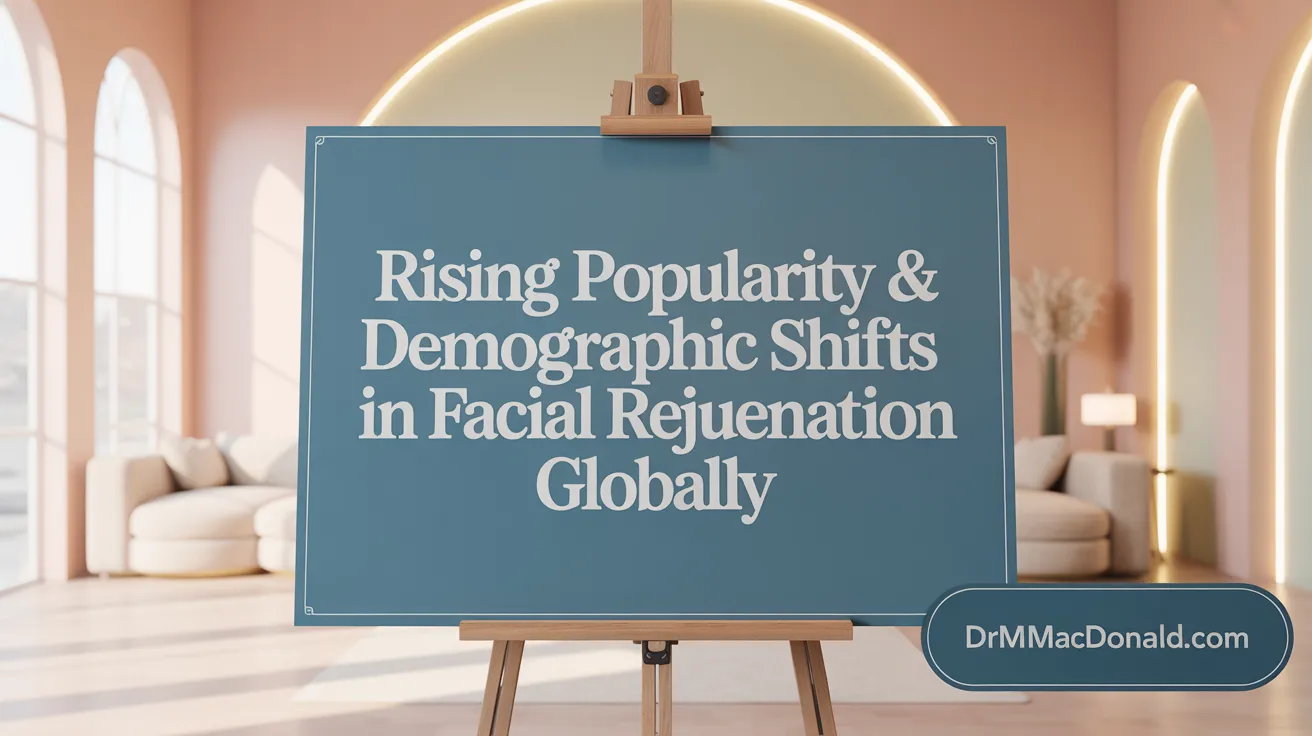
What are the national trends in facial rejuvenation procedures, focusing on popularity and demographic patterns?
Over recent years, facial rejuvenation has experienced a significant surge in popularity worldwide, particularly in North America and East Asia. The data from 2013 to 2023 reveals a consistent rise in both invasive and minimally invasive procedures, with a notable peak of 86 publications in 2021 (Facial rejuvenation publications 2013-2023). In the United States, nearly 92% of board-certified plastic surgeons perform facelifts regularly, with an average of 48 procedures per surgeon in 2023 (AAFPRS facelift statistics 2023). The trend is driven by advancements in technology like AI and 3D imaging, which enhance planning accuracy and outcome predictability (New Trends in Facial Plastic Surgery).
Regarding demographics, women continue to be the primary beneficiaries, comprising approximately 80-84% of facelift patients. However, the participation of men is increasing, with about 17–20% of facelift and other facial rejuvenation procedures being performed on males (facelift statistics by gender, Male cosmetic procedures trend). Men tend to favor surgical options such as facelifts and neck lifts early in their thinning years—often motivated by professional or social reasons (facelift reasons men, men's facelift motivations)—while women typically pursue these procedures for rejuvenation and self-confidence, often starting with non-invasive options like Botox or fillers (women's facelift motivations, female facelift statistics).
Age-wise, the 40-54 age group remains the most active demographic, but there is a rising trend among younger patients (ages 35-55), who seek early maintenance and preventive treatments (2024 AAFPRS survey results, Facelift popularity increase). This shift is influenced by social media, celebrity culture, and the 'Zoom Effect,' leading to increased client awareness of aesthetic options (New Trends in Facial Plastic Surgery).
Geographically, Western countries, especially the USA, dominate research and clinical practice, but East Asian countries such as Korea and China are also prominent, emphasizing features like nasolabial folds and glabellar lines (Global facial rejuvenation research trends). These regions tend to balance invasive and non-invasive procedures more evenly, reflecting cultural preferences and aesthetic standards (Facial rejuvenation research).
Influence of societal acceptance and technological advancements on procedure uptake
Societal perceptions of aging and beauty are evolving, becoming more accepting and open towards cosmetic procedures for all genders. This growing acceptance is reinforced by success stories, social media influence, and visible media portrayals (Demand for cosmetic surgery surge). Technological innovations like minimally invasive techniques, regenerative medicine, and high-definition imaging contribute to greater safety, quicker recovery, and natural-looking results, further broadening appeal (Future of regenerative facial medicine, Facial rejuvenation procedures research).
Younger generations, especially Gen Z, emphasize early intervention, maintenance, and subtle enhancements, which are often facilitated by these advanced technologies (AAFPRS 2024 annual survey). The public’s increasing comfort with cosmetic procedures and the marketing strategies tailored toward different age and gender groups continue to propel the upward trend in facial rejuvenation globally (Plastic Surgery Statistics 2024, Male cosmetic procedures trend).
2. Gender-Specific Motivations and Treatment Preferences in Facial Rejuvenation
How do gender differences manifest in interest and participation in facial rejuvenation procedures?
Gender differences in facial rejuvenation procedures are evident through distinct motivations, aesthetic goals, anatomical features, and treatment preferences. Women have historically been the primary demographic for aesthetic treatments, often motivated by societal beauty standards and personal desires for a softer, youthful appearance. They tend to seek non-invasive options initially, such as Botox and dermal fillers, aiming for natural and gradual improvements to enhance femininity (Nonsurgical cosmetic procedures for men, Plastic Surgery Statistics 2024, Facelift Patients Gender Breakdown).
In contrast, men, although initially a minority, are showing increasing interest driven by desires to maintain a masculine look, professional competitiveness, and to combat signs of aging like wrinkles and hair loss (Men choosing facial enhancements, Male Cosmetic Procedures Trend, Plastic surgery trends among men). Men often prefer surgical options, such as facelifts, neck lifts, or focused treatments on the jawline, to achieve sharper contours and a more energized appearance (female facelift statistics, Facelift Patients Gender Breakdown, Differences Between Men and Women in Facial Plastic Surgery). They favor procedures that provide quick results and minimal downtime.
Anatomically, men typically have thicker skin, larger facial bones, and more prominent features like supraorbital rims and a squarer jawline, which influence treatment approaches (Differences Between Men and Women in Facial Plastic Surgery, female facelift statistics). For instance, men may require higher doses of neurotoxins or specific injection techniques to preserve their masculinity and natural features (Injectable filler locations in men and women, Nonsurgical cosmetic procedures for men).
Preferred procedures: surgical vs. non-surgical
Women generally begin with less invasive treatments—Botox, fillers, chemical peels—and gradually transition to surgical procedures like facelifts or eyelid surgery as aging progresses (New Trends in Facial Plastic Surgery, Trends in Cosmetic Procedures 2023, Plastic Surgery Statistics 2024).
Men, on the other hand, tend to choose surgical interventions earlier in the aging process, often motivated by concerns about maintaining a rugged, youthful look suitable for professional and social settings. They usually seek procedures that emphasize strong jawlines and a broad forehead, sometimes opting for neck lifts or facial contouring (Facelift statistics by gender, Plastic surgery trends among men, Male Cosmetic Procedures Trend).
Anatomical considerations influencing treatment approaches
Key anatomical differences influence how treatments are planned and executed for each gender. Men’s thicker skin, denser collagen content, and distinctive facial structures—such as wider chins and more prominent skeletal features—necessitate tailored approaches (Differences Between Men and Women in Facial Plastic Surgery, female facelift statistics).
The surgical and non-surgical strategies incorporate these differences by adjusting injection techniques, dosages, and surgical methods to achieve natural, masculine results without over-softening features (Injectable filler locations in men and women, Nonsurgical cosmetic procedures for men).
Influence of societal perceptions and cultural factors on gender interest
Societal perceptions are gradually shifting, promoting a more inclusive view of cosmetic surgery across genders. Destigmatization and increased visibility of male cosmetic procedures have contributed to a growing acceptance among men (Plastic surgery trends among men, Men choosing facial enhancements, Male Cosmetic Procedures Trend).
Cultural factors also play a role: women often seek subtle enhancements aligning with societal standards of beauty, whereas men focus on strengthening masculine features and maintaining a professional, energetic appearance (Facelift Patients Gender Breakdown, Differences Between Men and Women in Facial Plastic Surgery).
Overall, gender influences the motivations and choices surrounding facial rejuvenation. Surgeons now increasingly consider these differences to customize treatments that meet individual aesthetic goals, societal expectations, and anatomical needs—leading to better outcomes and higher satisfaction for both men and women (Facial rejuvenation publications 2013-2023, AAFPRS facelift statistics 2023).
Statistical Insights on Gender Popularity in Facial Rejuvenation Procedures
Breakdown of patient percentages by gender
Recent data consistently shows that a majority of facial rejuvenation procedures are performed on women, accounting for approximately 70-80% of patients. Men, while still representing a smaller segment at about 20-30%, are demonstrating increased interest over recent years. For example, studies from various reputable organizations highlight that in 2024, roughly 84% of facelift patients are women, with men making up around 16% (Facelift Patients Gender Breakdown, AAFPRS facelift statistics 2023, Plastic Surgery Statistics 2024). These shifts are linked to changing societal norms and a growing acceptance of male aesthetic procedures (Plastic surgery trends among men, PlasticSurgery.org facelift data).
Trends in procedural growth among men
The number of minimally invasive treatments among men is rising rapidly. For instance, neurotoxin injections—commonly used for wrinkle reduction—have seen significant annual increases, with some reports indicating growth rates as high as 11.5% in the 2014 period, up from 9.2% in 2005 (Nonsurgical cosmetic procedures for men, Men's Facial Rejuvenation Trends, Male Cosmetic Procedures Trend). Men are increasingly seeking treatments like dermal fillers, eyelid surgeries, and facial fat grafting, driven by motivations to maintain a youthful and energetic appearance for professional and personal reasons (Plastic surgery trends among men, Men's Facial Rejuvenation Trends).
Skin condition studies highlighting gender differences
Skin analyses reveal distinct differences between men and women. AI skin assessment studies demonstrate that women tend to have higher scores in parameters like Sagging, Wrinkles, and Pigmentation. Conversely, men often exhibit more prominent Eye Bags and Translucency, with skin parameters such as Dark Circles and Redness being similar across genders (Injectable filler locations in men and women, Differences Between Men and Women in Facial Plastic Surgery). These differences influence treatment approaches, underscoring the importance of customized plans tailored to each gender.
Importance of personalized, gender-specific treatment planning
Given the anatomical and physiological differences—such as thicker skin and larger facial features in men—surgeons emphasize gender-specific techniques for facial rejuvenation. For men, procedures typically focus on defining contours and maintaining masculinity, often favoring less invasive, quicker results. Women, on the other hand, often prefer more subtle, natural enhancements aimed at softening wrinkles and restoring volume. Recognizing these differences ensures outcomes that are both natural-looking and aligned with each patient's aesthetic goals (The Female Facelift vs The Male Facelift, Differences Between Men and Women in Facial Plastic Surgery).
| Aspect | Women (Approximate %) | Men (Approximate %) | Notable Differences |
|---|---|---|---|
| Procedure participation | 70-80% | 20-30% | Women dominate, but male interest increasing (facelift patient gender breakdown) |
| Common treatments | Fillers, Botox, laser | Neurotoxins, fillers | Treatment preferences differ due to anatomical and societal factors (Nonsurgical cosmetic procedures for men) |
| Skin assessment parameters | Higher Sagging, Wrinkles | Prominent Eye Bags | Skin differences necessitate gender-specific approaches (Injectable filler locations in men and women) |
| Surgical focus | Volume, wrinkle smoothing | Contour, masculinity | Tailored surgical strategies for natural results (The Female Facelift vs The Male Facelift) |
The evolving trends underscore the importance of understanding gender-specific characteristics for optimal facial rejuvenation results. Ongoing research and increasing male participation reflect societal shifts and the broader acceptance of aesthetic treatments across all genders (Facial rejuvenation publications 2013-2023, Plastic surgery trends among men, AAFPRS 2024 annual survey).
Comparing Treatment Goals, Satisfaction, and Motivations by Gender
How do treatment goals, satisfaction, and motivations differ between males and females undergoing facial rejuvenation?
Treatment objectives in facial rejuvenation vary notably between men and women. Women generally pursue procedures aimed at reducing wrinkles, restoring volume, and achieving a natural, youthful appearance that enhances femininity. Their motivation often stems from a desire to boost self-confidence and to address signs of aging discreetly, favoring subtle enhancements that maintain a soft, natural glow (facelift reasons women, women's facelift motivations, female facelift statistics).
In contrast, men often seek facial procedures that emphasize maintaining or enhancing masculine features such as a sharper jawline, stronger chin, and defined neck contours. Their primary motivation centers around looking energetic, capable, and youthful for professional reasons or social confidence. Men tend to prefer more immediate, surgical options like facelifts or neck lifts early in their aging process (facelift reasons men, men's facelift motivations, men's preferences in cosmetic procedures).
Differences in satisfaction levels and expectations
Both genders generally report high satisfaction rates post-procedure, with preferences shaped by their distinct goals. Women tend to emphasize the importance of natural results, with satisfaction linked to a subtle, refreshed appearance that harmonizes with their features. They are often concerned with concealing scars and minimizing visible signs of recovery (facelift patient satisfaction rates, women and facelift satisfaction rates).
Men, on the other hand, often value sharper, more defined facial contours and are usually less concerned about subtlety during healing. They may utilize facial hair, like beards, to hide post-surgical bruising or swelling, and their satisfaction is linked to achieving a rejuvenated look that preserves masculinity (male facelift motivations, men using facial hair to hide bruising).
Varied motivations such as self-confidence vs. masculinity preservation
Women's motivations often focus on rejuvenation to improve self-esteem, address menopausal or age-related changes, and achieve a more youthful, attractive appearance that aligns with societal beauty standards. This includes transitioning from non-invasive treatments to surgical options as necessary (societal trends in cosmetic surgery, menopause-related facial rejuvenation).
Men's motivations are increasingly driven by maintaining a competitive edge in social and professional environments, emphasizing the preservation of masculinity and a robust image. They aim for treatments like facelifts or neurotoxin injections to soften lines while retaining their distinctive features (facelifts and career reasons for men, Trends in male nonsurgical cosmetic treatments).
Impact of anatomical differences on treatment outcomes
Biological distinctions significantly influence treatment approaches and results. Men possess thicker skin, more collagen, and a larger musculature, which can affect how procedures are performed and healed. For example, men tend to bleed more during surgery, and their denser tissues require different techniques, doses, and considerations to optimize results (Differences Between Men and Women in Facial Plastic Surgery, skin characteristics in male facelifts).
Conversely, women may have more delicate skin and softer tissue, benefiting from less aggressive techniques that focus on volume restoration and wrinkle smoothing (skin characteristics in female facelifts).
Overall, understanding these gender-based differences in anatomy, expectations, and motivations allows surgeons to tailor procedures effectively, leading to higher patient satisfaction and more natural, balanced results (Gender-Based Planning in Facial Plastic Procedures, facelift patient satisfaction).
Specific Facial Procedures and Their Gender-Based Trends
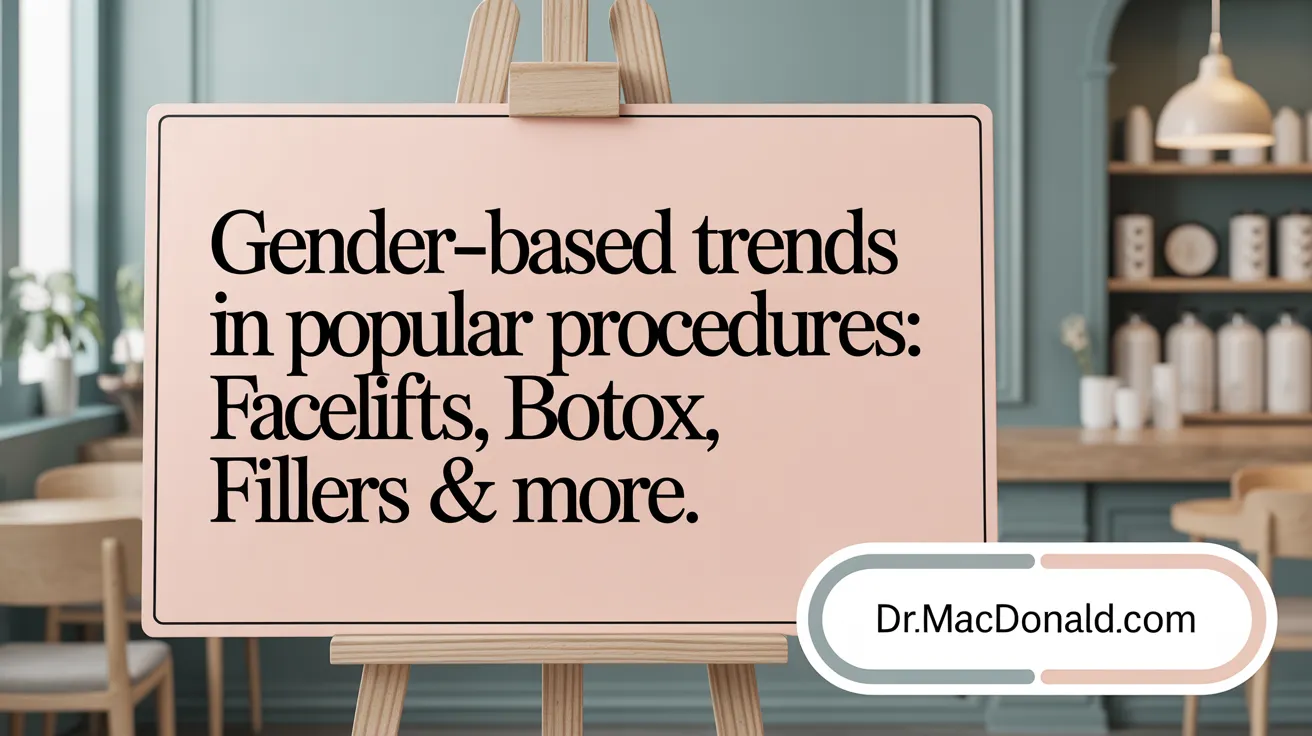
Which facial rejuvenation procedures show differing trends among genders, such as facelifts, Botox, and fillers?
Facial rejuvenation trends clearly differ between men and women, influenced by both biological factors and societal expectations. Women primarily seek minimally invasive treatments like Botox and dermal fillers, aiming for subtle, natural enhancements that restore a youthful glow and soften wrinkles. They often begin with non-surgical options and progress to surgical procedures like facelifts as they age, focusing on rejuvenation and self-confidence.
In contrast, men tend to favor surgical interventions such as facelifts, neck lifts, and other permanent solutions to maintain a masculine, energized appearance. Men’s treatments generally emphasize features like a sharper jawline and defined contours, aligning with their anatomical structures (Differences Between Men and Women in Facial Plastic Surgery). Neurotoxin injections like Botox also see rising popularity among men, mainly used to soften expression lines without compromising masculinity (Nonsurgical cosmetic procedures for men).
Men’s preference for surgical procedures versus women’s gradual approach
Men usually seek more immediate, surgical results rather than a gradual transition. They tend to prefer comprehensive procedures like facelifts or neck lifts in one session, often motivated by professional and social pressures to appear youthful and vigorous (Male Cosmetic Procedures Trend).
Women’s approach is typically more conservative initially, starting with non-invasive procedures like Botox or fillers, which require less downtime and are easier to conceal during recovery. As they age or as their skin loses elasticity, women often consider surgical options for more dramatic rejuvenation (female facelift statistics).
Anatomical and aesthetic rationales behind differing choices
The different preferences stem from inherent anatomical distinctions. Men usually have thicker skin, larger facial bones, and more prominent features such as a square jaw and heavier brow, all of which influence treatment planning (Gender-Specific Facial Features in Cosmetic Care). Their skin’s robustness makes them suitable for surgical results and allows for more aggressive interventions.
Women tend to have softer facial features, with more oval faces and less pronounced jawlines, leading to a preference for treatments that enhance volume, restore facial fullness, and achieve a delicate, natural appearance (female facelift facial shape).
Emergence of inclusive and gender-neutral aesthetic practices
As societal perceptions evolve, there is a growing movement toward inclusive and gender-neutral aesthetic practices. Patients of all genders are requesting personalized treatments that emphasize natural features without overtly conforming to gender stereotypes (Inclusive facial plastic surgery approaches).
This shift is influenced by broader cultural changes promoting acceptance of diverse gender identities and expressions. Accordingly, clinics are adopting more gender-neutral approaches, offering customized procedures that respect individual aesthetic goals, whether that involves softening wrinkles, contouring the jawline, or enhancing specific facial features (Gender differences in facelift motivations).
Overall, these trends highlight a more inclusive future for facial rejuvenation, where treatments are tailored to personal preferences and anatomical considerations, transcending traditional gender norms to promote natural, authentic beauty.
Demographic and Regional Influences on Gender-Specific Interest
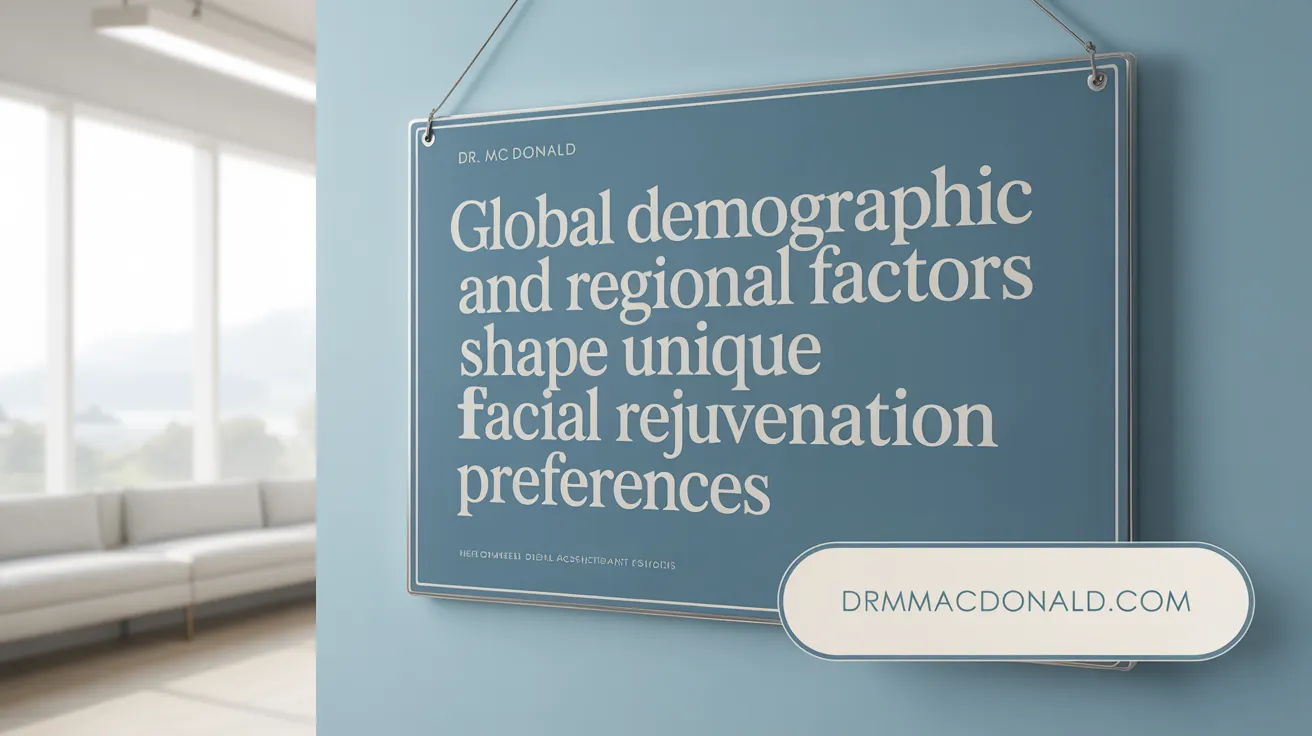
How do age groups impact procedural preferences for facial rejuvenation?
Age is a crucial factor shaping the type of procedures men and women pursue for facial rejuvenation. Younger individuals, particularly those under 35, often favor non-invasive treatments like Botox and dermal fillers to maintain a fresh appearance and prevent aging signs. As patients age into their 40s and 50s, interest shifts toward surgical procedures such as facelifts and neck lifts, which offer longer-lasting rejuvenation.
Data from the American Academy of Facial Plastic and Reconstructive Surgery (AAFPRS) highlights a rising trend in facelifts among the 35-55 age group, reflecting a desire for more significant, durable results. Additionally, younger patients are increasingly interested in early maintenance to slow down visible aging. Conversely, older demographics tend to opt for repeat procedures or combinations to address sagging skin, volume loss, and wrinkles.
What regional and cultural factors influence treatment choices?
Regional and cultural norms considerably affect how gender-specific customers approach facial rejuvenation. Western countries, especially the USA, Korea, and China, dominate research and treatment trends, often emphasizing antiaging and youthful aesthetics. In Western cultures, societal perceptions favor subtle, natural-looking enhancements, with women often starting with minimally invasive procedures.
In East Asia, cultural attitudes towards beauty and skin aging guide preferences; for example, treatments like laser therapy and botulinum toxin are popular, especially for reducing nasolabial folds and glabellar lines. Moreover, East Asian populations tend to focus on procedures suited for darker phototypes, where pigmentation issues and skin resilience influence the choice of interventions. These points are supported by comprehensive facial rejuvenation research highlighting differences in invasive and noninvasive treatments across regions.
How do urban settings and socioeconomic factors influence cosmetic demand?
Urban environments usually report higher demand for facial rejuvenation procedures due to greater aesthetic awareness, access to clinics, and peer influence. Affluent neighborhoods are associated with increased pursuit of cosmetic enhancements, driven by exposure to media and social standards of beauty.
Higher socioeconomic status correlates with willingness to undergo more invasive or comprehensive treatments, including surgical options. Additionally, education levels influence awareness and acceptance of cosmetic procedures. People in urban, wealthy settings are also more likely to be familiar with newer technologies, such as regenerative medicine, which are gaining popularity globally as noted in the AAFPRS 2024 statistics.
What role do ethnic considerations play in skin aging and procedure outcomes?
Ethnic factors influence skin characteristics like elasticity, collagen density, and pigmentation, shaping treatment preferences and outcomes. Darker skin phototypes may respond differently to certain lasers and chemical peels, and are more prone to pigmentation issues, guiding clinicians to tailor treatments to minimize adverse effects.
For example, ethnic patients may prefer non-invasive options to reduce risks of hyperpigmentation. The understanding of these differences is vital for surgeons to achieve natural results and improve patient satisfaction. Such considerations also affect procedural techniques, recovery times, and the types of interventions deemed most appropriate, as detailed in studies on gender-specific and ethnic differences in facial plastic surgery.
| Demographic & Regional Factors | Influence on Patient Preferences | Specific Considerations |
|---|---|---|
| Age groups (young vs. older) | Non-invasive vs. surgical choices | Prevention in youth, correction in older |
| Regions (Western vs. East Asian) | Aesthetic goals and treatment focus | Natural look, pigmentation issues |
| Socioeconomic status | Access and willingness | Urban, affluent populations more active |
| Ethnic background | Skin response and pigmentation | Customized techniques for darker skin |
Understanding these demographic and regional influences enables clinicians to tailor treatments effectively, ensuring each patient's unique background and preferences are prioritized in facial rejuvenation strategies. For further reading on facelift patient gender breakdown and demographics or male-focused cosmetic treatment trends, see the linked resources.
Societal and Cultural Aspects Shaping Gendered Facial Rejuvenation Trends
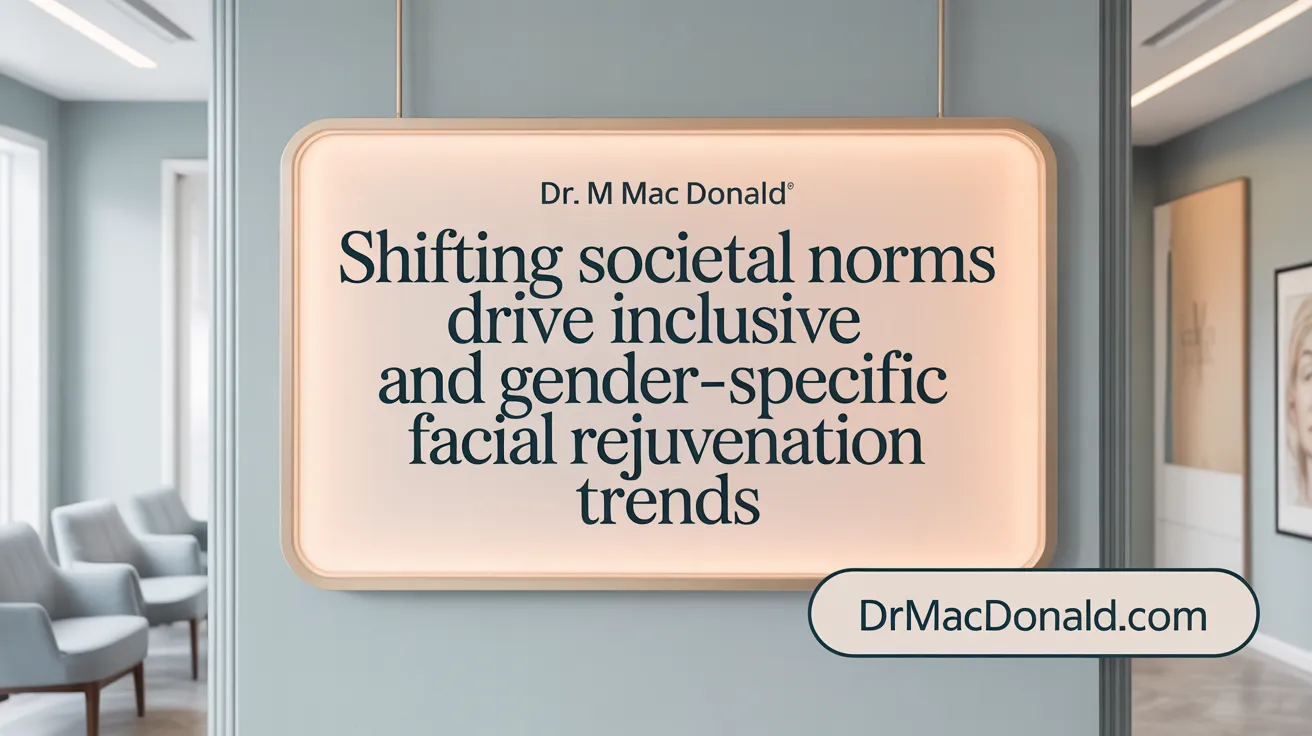
How do evolving societal perceptions and cultural factors impact male and female interest in cosmetic facial procedures?
Changing societal perceptions and cultural influences play a significant role in shaping attitudes toward facial rejuvenation among men and women. Historically, cosmetic procedures were stigmatized, especially for men, but this has shifted substantially in recent years. Increased visibility of cosmetic surgeries in media, celebrity endorsements, and endorsements from social media influencers have normalized these treatments for both genders (New Trends in Facial Plastic Surgery).
In many cultures, particularly Western societies, there is a growing acceptance of men seeking cosmetic enhancements, driven by the idea that youthful and energetic appearances are linked to professional success and social relevance (Plastic surgery trends among men, Nonsurgical cosmetic procedures for men). This societal shift encourages more men to pursue procedures like Botox, facelifts, and non-invasive treatments, reducing stigma and making such options more accessible (AAFPRS facelift statistics 2023).
Conversely, women have traditionally been more accepted to undergo cosmetic procedures to align with societal standards of beauty. Media portrayals emphasizing youthful looks and flawless skin continue to motivate women to seek rejuvenation treatments, often aiming for subtle, natural results (Facelift Patients Gender Breakdown).
In collectivist cultures, social pressures and gender expectations can influence the motivation to undergo facial procedures. For example, in some societies, men are encouraged or even expected to maintain a youthful appearance to remain competitive at work, and women often face societal pressures to adhere to evolving beauty standards (Differences Between Men and Women in Facial Plastic Surgery).
Overall, as societal norms continue to evolve, they increasingly support and influence both men and women to consider facial rejuvenation, breaking down previous stigmas and broadening the demographic and cultural scope of those seeking treatments (Facelift statistics by gender, Male Cosmetic Procedures Trend).
Anatomical and Aesthetic Factors Guiding Gender-Specific Treatments
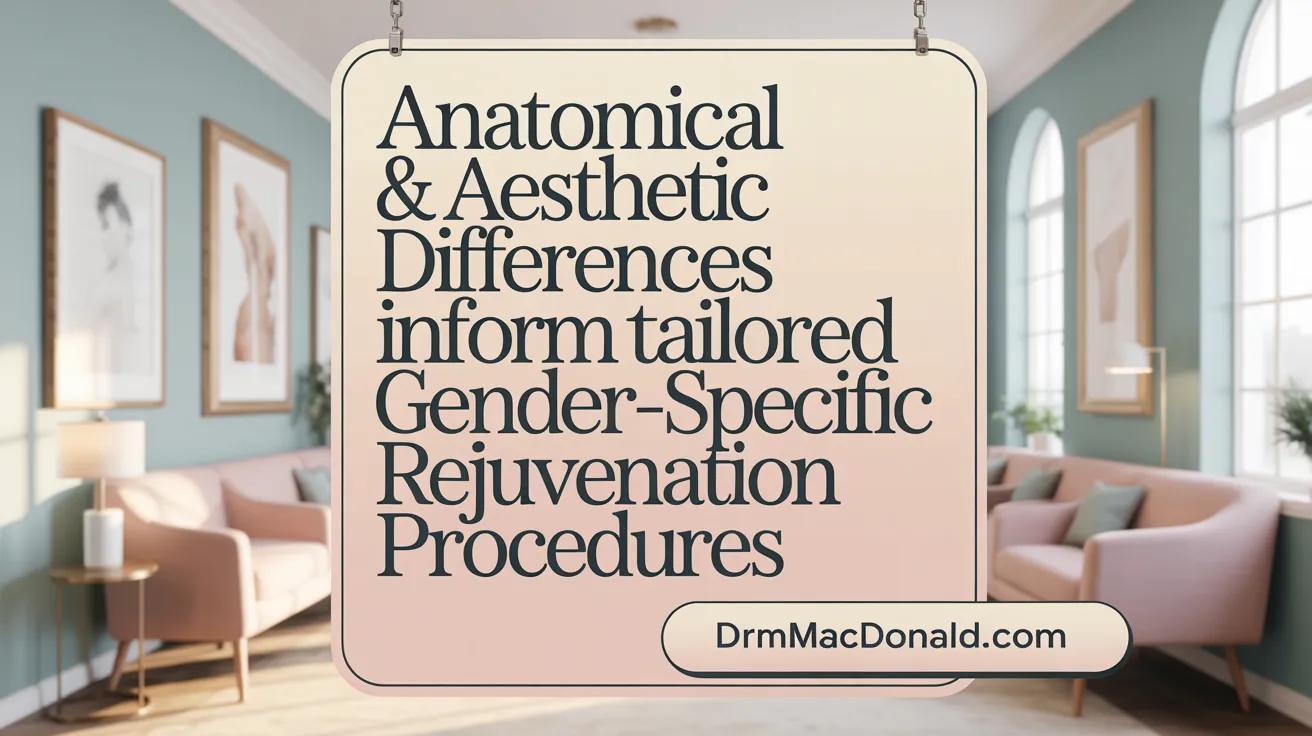
What anatomical and aesthetic considerations influence gender-specific approaches to facial rejuvenation?
Gender-specific facial anatomy and aesthetic goals play a crucial role in tailoring facial rejuvenation procedures. Men and women have distinct skeletal structures, skin characteristics, and fat distribution patterns, which guide surgeons to select techniques that emphasize natural, gender-appropriate results. For detailed insights on differences between men and women in facial plastic surgery and gender-specific facial features in cosmetic care, see relevant research.
In men, the jawline tends to be broader and more angular, with a squarer face shape. Their skin is approximately 25% thicker with higher collagen density, resulting in greater robustness and different aging patterns like hollowed eyes or deep facial lines. These features necessitate surgical approaches that preserve masculinity, such as emphasizing a strong jawline, maintaining facial hair patterns, and avoiding overly softening procedures. Incision placement and tissue support are adapted to sustain the masculine contour and avoid feminization. For more on male facelift anatomy and techniques, please refer to specialized resources.
Women typically have softer, more oval or heart-shaped facial contours with higher cheekbones and more pronounced nasolabial folds. Their skin is generally thinner and more elastic, leading to different aging signs like wrinkles and volume loss in areas like the cheeks and around the mouth. Rejuvenation strategies focus on restoring volume and softness, enhancing femininity through subtle lift techniques, fillers, and skin tightening procedures that follow natural facial lines. See comprehensive data on female facelift statistics and motivations and advancements in facial rejuvenation procedures.
How do these differences influence procedural approaches?
Procedures like facelifts are customized: in men, techniques aim to accentuate the jawline and avoid altering masculine features, often incorporating muscle-tightening and minimal fat removal around the neck. For women, lifts and fillers are more targeted to lift sagging skin and soften features for a natural, youthful look. Detailed trends and gender-specific procedural differences are discussed in sources covering facelift patient demographics by gender and female vs. male facelift differences.
Surgeons also consider skin thickness and healing characteristics—for instance, men may bleed more and have a different recovery profile—requiring adjustments in surgical technique and postoperative care. See insights on postoperative care and recovery differences by gender.
Balancing natural results with gender identity in aesthetics
Achieving a natural and authentic appearance involves respecting each gender’s unique anatomy and aesthetic preferences. The goal is to enhance youthful features while maintaining the patient’s gender identity. For men, this often means emphasizing masculine contours with minimal feminization, and for women, restoring soft contours without creating an overdone look. Review discussions on facelift motivations and gender-specific aesthetic goals and male facial rejuvenation trends.
Surgeons utilize a nuanced understanding of anatomical differences to craft personalized treatment plans that align with each patient’s goals, ensuring results that appear harmonious and natural. Proper technique and precise planning allow for subtle enhancements that support gender-specific aesthetic ideals, fostering both confidence and satisfaction. Further studies on facial rejuvenation research trends and gender differences in cosmetic procedure preferences provide scientific context for these approaches.
Industry Growth, Market Trends, and Emerging Gender-Specific Procedures
What are the current industry and market trends, including growth projections and emerging procedures, segmented by gender?
The facial rejuvenation industry is experiencing a dynamic growth trend that reflects broader societal shifts and technological advancements. Globally, the skincare and aesthetic procedures market is projected to reach approximately USD 212.96 billion by 2032. This expansion is fueled by increasing consumer interest across both genders, with a noticeable rise in male participation.
Both invasive procedures like hyaluronic acid fillers and botulinum toxin (Botox or neurotoxins) continue to be popular. At the same time, noninvasive treatments such as laser therapy, radiofrequency (RF), and topical skin care are seeing increased demand. Interestingly, regional preferences influence the choice of treatments. Western countries tend to focus more on invasive interventions, benefiting from extensive research and innovation, whereas East Asian markets often balance invasive and noninvasive options based on local aesthetic standards (source).
Research activity related to facial rejuvenation peaked around 2021, with high-quality randomized controlled trials (RCTs) constituting roughly 70% of publications. The majority of this research originates from Western nations like the United States, Korea, and China, although collaborations with Asian researchers are increasing (source).
A major trend is the rising involvement of men in aesthetic procedures. Data shows that procedures like neuromodulator injections have increased significantly among males, with the men's skincare segment valued at USD 21.8 billion in the United States alone in 2021. Men typically seek treatments that offer quick results with minimal downtime, such as Botox, fillers, and laser treatments, aligning with their preference for subtle, natural-looking enhancements (source; source).
The demographic broadening is further evidenced by the increased interest from younger populations, including Gen Z, who emphasize early maintenance and prevention. Additionally, the industry is adapting marketing strategies to effectively reach and serve gender-specific needs, emphasizing natural results and sustainability (source).
Overall, the evolving landscape underscores a shift towards more personalized, gender-specific approaches in facial rejuvenation, driven by technological innovation, demographic changes, and societal acceptance. This creates a diverse, expanding market, with continuous innovation expected as research and patient preferences evolve (source).
Future Outlook and Emerging Patterns in Male and Female Facial Rejuvenation Participation
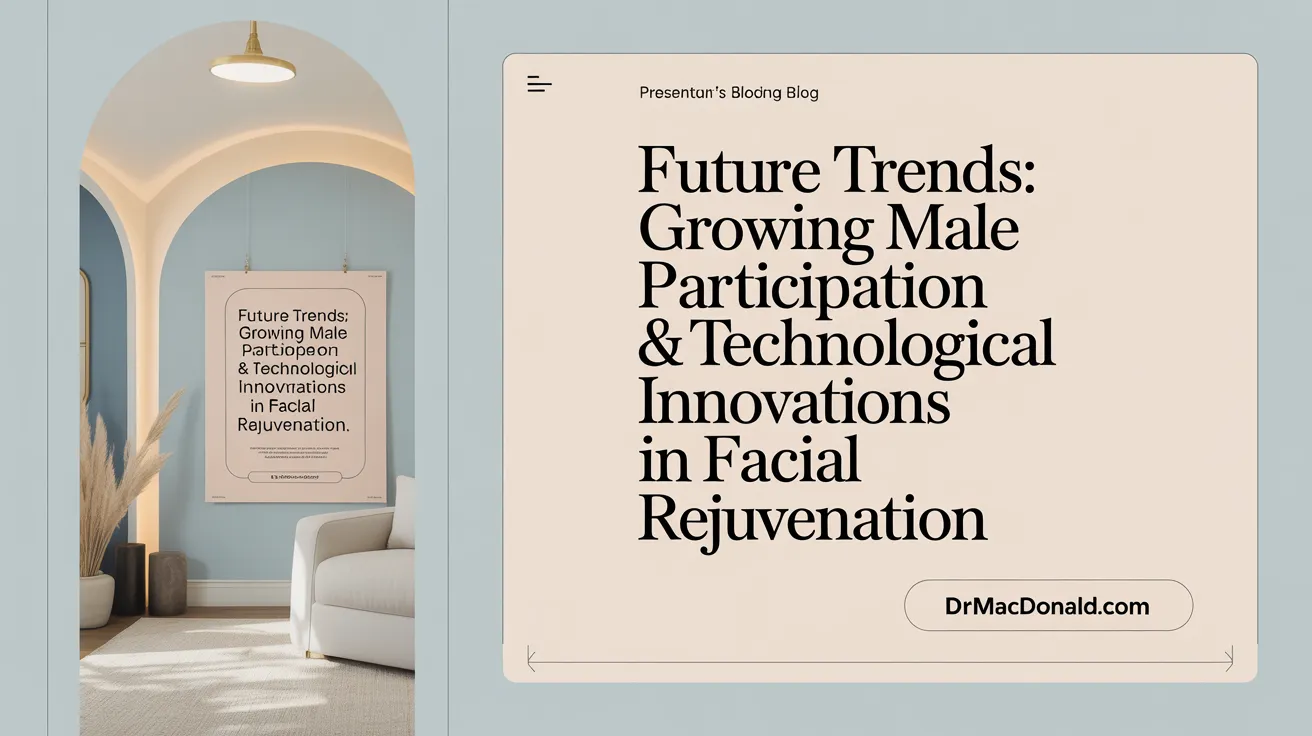 The landscape of facial rejuvenation is set to evolve significantly in the coming years, with increasing participation from both men and women. Societal attitudes toward cosmetic procedures are shifting, fostering greater acceptance and destigmatization of aesthetic treatments for men (Nonsurgical cosmetic procedures for men, Male Cosmetic Procedures Trend, Plastic surgery trends among men). This change is driven by a desire among men to maintain a youthful, energetic appearance to stay competitive professionally and socially, as well as a broader cultural acceptance of male grooming (Facelift trends for men and women, Men's Facial Rejuvenation Trends). Consequently, the future sees a steady rise in male engagement, with procedures such as neurotoxin injections, liposuction, and even surgical face and neck lifts gaining popularity (Increase in facelift patients aged 35-55, Male plastic surgery procedures).
The landscape of facial rejuvenation is set to evolve significantly in the coming years, with increasing participation from both men and women. Societal attitudes toward cosmetic procedures are shifting, fostering greater acceptance and destigmatization of aesthetic treatments for men (Nonsurgical cosmetic procedures for men, Male Cosmetic Procedures Trend, Plastic surgery trends among men). This change is driven by a desire among men to maintain a youthful, energetic appearance to stay competitive professionally and socially, as well as a broader cultural acceptance of male grooming (Facelift trends for men and women, Men's Facial Rejuvenation Trends). Consequently, the future sees a steady rise in male engagement, with procedures such as neurotoxin injections, liposuction, and even surgical face and neck lifts gaining popularity (Increase in facelift patients aged 35-55, Male plastic surgery procedures).
A clear trend toward minimally invasive and nonsurgical procedures dominates current research and market growth. Men, in particular, favor quick, effective treatments like Botox and fillers, which offer subtle but noticeable improvements with minimal downtime (Trends in male nonsurgical cosmetic treatments, New Trends in Facial Plastic Surgery). Women continue to seek natural-looking rejuvenation, often starting with non-invasive options and progressing to surgical interventions as they age, emphasizing a gradual enhancement approach (Female facelift statistics, Facelift patient satisfaction rates).
Technological advancements are playing a pivotal role in personalizing facial rejuvenation strategies. AI-driven tools and 3D imaging allow for precise analysis, customized treatment planning, and outcome prediction, enabling surgeons to tailor procedures more effectively to individual anatomy and aesthetic goals (AAFPRS 2024 annual survey, New Trends in Facial Plastic Surgery). This technological integration ensures that results are not only more natural but also aligned with each gender’s unique features (Gender-Specific Aging and Surgery Needs).
Moreover, early intervention and preventive care are becoming increasingly important. Younger patients, especially those from Generation Z, are showing an interest in maintaining youthful features through early, less aggressive treatments (Gen Z early aesthetic maintenance trend, Popularity Surge in Lip Lifts and Blepharoplasties). This proactive approach aims to delay the visible signs of aging and promote skin health, broadening the demographic reach of facial rejuvenation practices (Trends in Cosmetic Procedures 2023).
In summary, the future of facial rejuvenation is characterized by diversified participation, technological innovation, and a focus on natural, gender-specific results. Both men and women are expected to continue embracing these procedures, with ongoing research ensuring more refined, personalized, and effective outcomes (Facial rejuvenation publications 2013-2023, Facelift patient gender breakdown). These trends will ensure that facial rejuvenation remains at the forefront of aesthetic medicine as it adapts to evolving societal norms and technological boundaries.
Looking Ahead: The Evolving Landscape of Facial Rejuvenation
As facial rejuvenation procedures become more widespread and culturally accepted, the industry is witnessing a dynamic shift in gender participation, preferences, and treatment modalities. Women continue to lead in numbers but men are rapidly gaining ground, driven by evolving societal norms, career aspirations, and advancements in minimally invasive technologies. Understanding the intricate interplay of anatomical, psychological, and cultural factors is essential for professionals aiming to deliver personalized, effective, and natural results. The future promises further innovation and inclusivity, with the potential to redefine aesthetic ideals across genders and age groups, empowering individuals to confidently embrace their unique beauty journeys.
